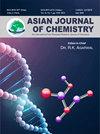新型苯并吡喃嘧啶的合成、表征及其溶色行为研究
Q4 Chemistry
引用次数: 0
摘要
以二氧化硅-硫酸为催化剂,分三步合成了五种新的苯并吡喃嘧啶(5a-e)。通过 1H NMR、13C NMR、IR 和质谱等光谱技术对所有合成的具有不同取代基的苯并吡喃嘧啶进行了表征。这些分子的结构特征包括嘧啶环与π-共轭体系以及芳香环上的各种官能团,这些特征极大地影响了它们的光物理特性。因此,它们更适合开发光电材料。因此,建议对它们在各种极性和非极性有机溶剂(即二氯甲烷、四氢呋喃、乙酸乙酯、乙腈和乙醇)中的溶解变色行为进行合成、表征和研究。有趣的是,除了化合物 5e 在四氢呋喃中表现出更大的斯托克偏移(λf-λa)外,所有目标分子在二氯甲烷中都表现出更大的斯托克偏移(λf-λa),这可能是由于溶剂的中等极性。合成的苯并吡喃嘧啶在不同的有机溶剂中显示出溶解变色特性,这是因为环上存在多个取代的官能团。由于其显著的特性,它们可以作为未来研究光电材料的潜在候选分子。本文章由计算机程序翻译,如有差异,请以英文原文为准。
Synthesis, Characterization of New Benzopyran Pyrimidines and Study of their Solvatochromic Behaviour
Five new benzopyran pyrimidines (5a-e) were synthesized in three steps by using silica-sulphuric acid as catalyst. All the synthesized benzopyran pyrimidines with various substituents were characterized by spectroscopic techniques such as 1H NMR, 13C NMR, IR and mass spectroscopy. The structural features of these molecules containing pyrimidine ring with π-conjugated systems and various functional groups on the aromatic rings greatly influence their photophysical properties. Thus, they behave as better candidates for developing the photoelectric materials. Thus, it is proposed to synthesize, characterize and study their solvatochromic behaviour in various polar and non-polar organic solvents viz. dichloromethane, tetrahydrofuran, ethyl acetate, acetonitile and ethanol. Interestingly, all the target molecules exhibited greater Stoke’s shift (λf-λa) in dichloromethane except for compound 5e, which exhibited greater value in tetrahydrofuran, possibly due to the moderately polar nature of the solvent. The synthesized benzopyran pyrimidines displayed solvatochromic characteristics due to the presence of multiple substituted functional groups on the rings in different organic solvents. Due to their remarkable properties, they could serve as potential candidate molecules for future investigations into photoelectric materials.
求助全文
通过发布文献求助,成功后即可免费获取论文全文。
去求助
来源期刊

Asian Journal of Chemistry
化学-化学综合
CiteScore
0.80
自引率
0.00%
发文量
229
审稿时长
4 months
期刊介绍:
Information not localized
 求助内容:
求助内容: 应助结果提醒方式:
应助结果提醒方式:


